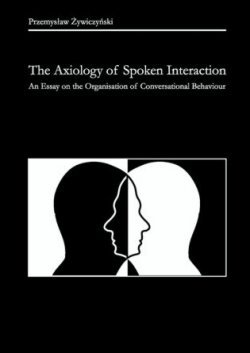Dr hab. Przemysław Żywiczyński pracuje jako adiunkt w Katedrze Filologii Angielskiej UMK w Toruniu. Jest autorem książek – Buddhism and Meaning (2004) and The Axiology of Spoken Interaction (2010) – oraz wielu artykułów z zakresu ewolucji języka, pragmatyki językoznawczej i buddologii.
The Axiology of Spoken Interaction. An Essay on the Organisation of Conversational Behaviour
Th is book owes a great deal to a great many people. To Dr. John Kearns, I am greatly indebted for untiring proofreading, expert editorial guidance and supporting the book from its inception. I am deeply grateful to Prof. Aleksander Szwedek and Prof. Piotr Stalmaszczyk for reading the entire manuscript and generously off ering advice, without which the completion of this work would have been diffi cult, if not impossible. My warm thanks go to my closest friends, who provided help in various forms, much needed during the four years of work on the project. In particular, my gratitude is due to Agnieszka Krzemień, whose careful reading dramatically improved the quality of the work, and Szymon Marciniak, who with patience and enthusiasm executed the almost one hundred fi gures contained in this book. I would also like to thank all my colleagues from the English Department at Nicolaus Copernicus University in Toruń for creating an atmosphere of inspiration and encouragement.
I owe the greatest debt to Prof. Tomasz Krzeszowski. First as an M.A. and then as a Ph.D. student, I had the great privilege of listening to him as a teacher and, later, of sharing ideas with him as a colleague. In retrospect, the decisive infl uence on my thinking about values was exerted during a seminar on linguistic axiology given by Prof. Krzeszowski at Nicolaus Copernicus University in the academic year 1995-1996. Th e seeds which were planted at that time, germinated and eventually led to this book.
Acknowledgements /13
Introduction /15
1. Setting the scene /15
2. Methodological considerations /16
3. Th e research domain /19
4. Th e design of the work /22
5. Editorial notes /24
Chapter I. Axiology - the science of values /25
1. Introduction /25
2. Th e pre-axiological phase of refl ection on values /28
3. Axiological intuitionism /32
3.1. Nietzschean beginnings /33
3.2. Axiological ethics /36
3.2.1. Setting the scene: the debate between Meinong and Ehrenfels /36
3.2.2. Scheler's material apriorism /37
3.2.3. Nicolai Hartmann's objectivist account of value and value hierachisation /39
3.3. Elzenberg's philosophical axiology /43
3.4. Puzynina on values in language /46
3.5. George E. Moore's axiological anti-naturalism /47
3.6. Robert S. Hartman's design of the axiological science /49
4. Emotivism /53
5. Naturalistic axiology /57
5.1. Mill and the foundation of naturalistic axiology /58
5.2. Dewey's axiological consequentialism and instrumentalism /59
5.3. Evolutionary approaches to the study of values /61
5.3.1. Spencer's normative meta-ethics /61
5.3.2. Th e Darwinian paradigm in the study of values: ethological axiology /62
5.3.3. Neo-Darwinism and evolutionary-psychological research on values /65
6 Contents
6. Angels and devils - language and values: Krzeszowski's framework for linguistic axiology /69
7. Concluding remarks /77
Part I. Th e axiological structure of conversation Prologue /81
1. Introduction /81
2. Models of conversation analysis /83
3. Concluding remarks /84
Chapter II. Discourse axiology and models of conversation analysis /86
1. Introductory notes on the axiology of discourse phenomena /86
2. Discourse axiology and the transactional model of conversation /90
3. Intra- and extra-discursive goals /97
4. Discourse domains /103
5. Transaction versus interaction /105
6. Text, discourse, and conversation /108
7. Spoken interaction versus conversation /111
8. Text openness and the discourse of spoken interaction /112
9. Concluding remarks /116
Chapter III. Discourse goals and discourse norms /118
1. Introduction /118
2. Axiology of discourse goals /118
2.1. Discourse goals in text linguistics /123
2.2. Ethological conception of discourse goals /126
2.2.1. Homeostatic appetence /129
2.2.2. Social homeostasis /133
2.2.3. Heterostatic appetence /136
2.2.4. Appetence, well-being, and the axiological structure
of discourse /140
2.3. Concluding remarks on discourse goals /146
3. Sociability and the normative dimension of discursive interaction /147
3.1. Ritualisation /151
3.2. Types of societal behaviour /154
3.3. Axiological signifi cance of sociability /156
3.4. Meta-discursive goals /160
3.5. Phatic communion, grooming talk, and discourse norms /164
3.6. Meta- and other types of discursive goals /166
3.7. Summing up discourse normativity /167
Contents 7
Chapter IV. Informativity as an aspect of intra-discursiveness /169
1. Introduction /169
2. Intra-discursive cooperation and the CP /169
3. Information structure and intra-discursive goals /172
4. Th e cybernetic model of informativity /179
4.1. Regulative integration and local axiological cycles /184
4.2. Textual informativity /184
4.3. Th e axiological signifi cance of downgrading /186
4.4. Informational defaults and verbal grooming /193
5. Local axiology beyond the cybernetic description /195
6. Concluding remarks /199
Chapter V. An interactional model of communicaton /201
1. Opening remarks /201
2. Turn-taking /202
3. Adjacency pairs and preference phenomena /203
4. Conversational games /207
4.1. Social and discourse games /209
4.2. Wittgenstein's conception of language games /210
5. Concurrence between preference and axiological phenomena /213
6. Invitations and off ers /215
6.1. Th e axiological organisation of invitations and off ers /217
6.2. Th e interactional and axiological signifi cance of dispreference phenomena /219
7. Requests /222
7.1. Preferential and dispreferential scenarios in the request game /223
7.2. Th e axiological organisation of dispreferred sequences in requests /225
8. Other- and self-benefi ting games compared /229
9. Questions /230
9.1. Th e structure of question-answer adjacencies /232
9.2. Defi nitional problems /233
9.3. Th e question game /237
9.3.1. Th e axiological organisation of the question game /241
9.3.2. Irregularities in the axiological and conversational organisation of the question game /241
9.4. Th e axiology of silence /245
9.5. Th e question game: a summary/249
10. Th e economic and normative dimensions of discourse /251
11. Normative games: assessments and self-deprecations /254
11.1. Th e assessment game /256
11.1.1. Conversational preference in assessments /258
11.1.2. Preference and iconicity /261
11.1.3. Dispreferred scenarios in the assessment game /262
11.1.4. Th e assessment game: a summary /266
8 Contents
11.2. Self-deprecations /266
11.2.1. Preference phenomena in the self-deprecation game /268
11.2.2. Dispreference in the self-deprecation game /271
11.3. Final comments on the nature of normative games /277
Chapter VI. Towards the axiological model of discourse: discourse as a normative and multi-teleological process /280
1. Opening remarks /280
2. Extra-discursive goals /281
2.1. Discursive cooperation and non-cooperation /286
2.2. Game-specifi c rules /289
3. Discourse norms and meta-discursive goals /290
4. Intra-discursive goals and discursive cooperation /294
5. Meta-discursive goals and discourse norms /298
6. Norms of discursive interaction and axiological phenomena /302
7. Th e axiological structure of conversation: the research hypothesis reconsidered /303
Part II. Discourse axiology and politeness phenomena
Prologue /309
1. Introduction /309
2. Normativity and evaluativity /310
3. Th e social foundation /313
4. Cooperation /315
5. Th e research programme for Chapters VII and VIII /316
Chapter VII. Politeness, territory, and disourse axiology /318
1. Introduction /318
2. Robin Lakoff /319
2.1. Distance /322
2.2. Deference /329
2.2.1. In-group marking /330
2.2.2. Out-group marking /339
2.3. Optative strategies and discourse dislocation /342
2.4. Types of discourse manipulation and types of linguistic politeness /352
2.5. Th e role of politeness in the axiological structure of discourse /355
3. Conclusion /368
Chapter VIII. Testing the proxemic model of politeness /369
1. Introduction /369
2. Leech's Grand Scheme /369
2.1. An overview of Leech's politeness model /371
Contents 9
2.2. Th e tact maxim and discourse dislocation /373
2.3. Indirectness and politeness /377
2.4. Discourse models and politeness /380
2.5. Leech's later proposals /388
2.6. Summary /389
3. Brown and Levinson's theory of politeness universals /391
3.1. Setting the comparative ground /395
3.2. Sociopetal processes in positive politeness /397
3.3. Negative politeness and sociofugal politeness /404
3.3.1. Iconic eff ects and the hierarchy of politeness strategies /405
3.3.2. Conventional indirectness and discourse dislocation /408
3.3.3. Impersonalisation and point-of-view distancing /411
3.3.4. Invoking cognitive asymmetry /413
3.3.5. Personal distancing /414
3.3.6. Concluding remarks on negative politeness /416
3.4. Politeness universals and axiology /418
4. Th e post-Brown and Levinson phase of politeness studies /425
4.1. Speaker-centredness, individualism, and confl ict avoidance /426
4.2. Face and facework according to Brown and Levinson /429
4.3. Th e habitus model /433
5. Concluding remarks /439
Chapter IX. A territorial perspective on politeness processes /441
1. Introduction /441
2. Spacing, aggression, and politeness /442
3. Territoriality /446
3.1. Dominance and hierarchy /447
3.2. Th e basic model of spacing /450
4. Territoriality, politeness, and axiology
5. Conclusion /457
Part III. Completing the proposal and going beyond
Chapter X. Interaction, ritual, and discourse axiology /461
1. Introduction and setting the comparative ground /461
2. Goff man's notion of face and its axiological relevance /462
3. Natural rituals versus conversation games /466
4. Face wants and the normative order of interaction /468
5. Anti-utilitarianism /472
6. Th e warp and weft of interaction /474
7. Facework processes and the axiological structure of discourse /477
7.1. Th e avoidance process /478
7.2. Th e corrective process /481
10 Contents
8. Interaction ritual /487
9. Th e model of discourse axiology revisited /494
10. Conclusion: assembling the parts /507
Epilogue /513
1. Th e goals of the project revisited /513
2. Future directions /516
3. Naturalistic axiology and the social foundation of discursive values/517
4. Norms, synagonal cooperation, and evolution /521
5. Final address /523
Appendix I /525
Appendix II /526
References /539
Internet Sources /562
Dictionaries /562
Name index /563
Subject index /566
List of fi gures /575
List of tables /579
Przemysław Żywiczyński
- Theoria et Historia Scientiarum, XIV (2017): Spectrality and Cognition: Haunted Cultures, Ghostly Communications
- Theoria et Historia Scientiarum, X (2013): Synesthesia
- Ewolucja języka. W stronę hipotez gesturalnych
- Theoria et Historia Scientiarum, XV (2018): Competence for Foreign Language Learning and Teaching
- Theoria et Historia Scientiarum, XVII (2020)
- Theoria et Historia Scientiarum, XVI (2019): How did language evolve? Biological, psychological, and linguistic perspectives
- The Axiology of Spoken Interaction. An Essay on the Organisation of Conversational Behaviour
- Theoria et Historia Scientiarum, IX (2012): Ways to protolanguage Contemporary problems in the evolution of language
- Buddhism and Meaning: Comparative Assessment of Buddhist Views on Cognition, Meaning, and Language
- Theoria et Historia Scientiarum, XI (2014): Multiple perspectives on language origins
Powiązane

Enjoying the spectacle: word, image, gesture. Essays in honour of Professor Marta Wiszniowska
Dariusz Pestka, Jerzy Sobieraj
Towards an integrated conceptual model of metaphorical linguistic expressions in English
Ariadna Strugielska
The Construction of Scientific Knowledge through Metaphor
Tomasz Fojt
Hauntology and Intertextuality in Contemporary British Drama by Women Playwrights
Edyta Lorek-JezińskaInne z tej kategorii

Za kulisami. Toruńskie spotkania wokół dramatu. Edycja czwarta

(Nie)oczywiste „Ziemie Odzyskane”

Pan Samochodzik i…







